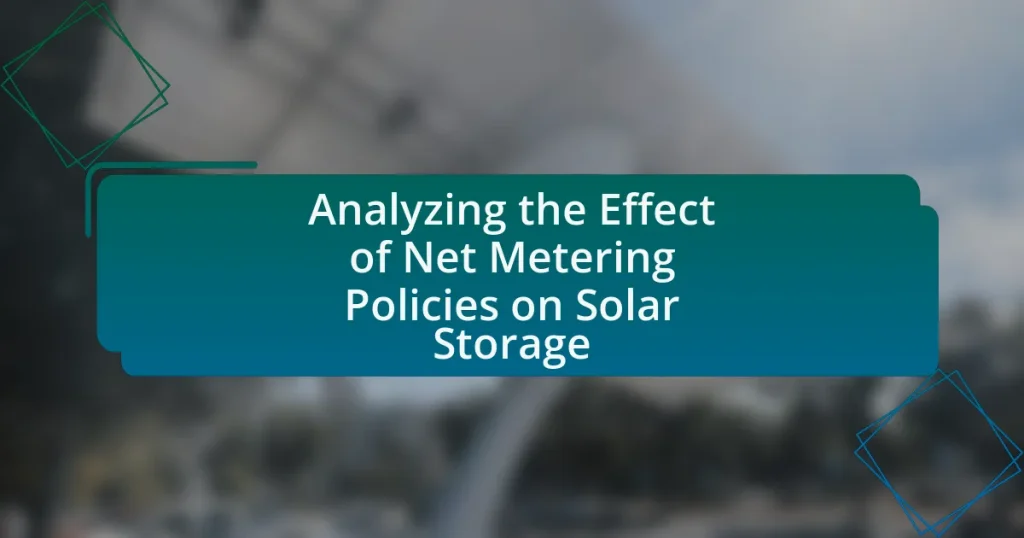Net metering policies are regulations that enable solar energy system owners to receive credits for the excess electricity they generate and feed back into the grid, promoting renewable energy adoption and reducing consumer energy costs. This article analyzes the functioning of net metering policies in relation to solar energy and storage, highlighting key components such as eligibility criteria, credit systems, and the interaction between solar technologies and these policies. It also examines the economic implications of net metering on solar storage investments, the challenges posed by regulatory frameworks, and future trends in policy evolution. The article emphasizes the importance of net metering in enhancing the viability of solar storage solutions and influencing consumer behavior towards energy independence.
What are Net Metering Policies and Their Purpose?


Net metering policies are regulations that allow residential and commercial solar energy system owners to receive credit for the electricity they generate and feed back into the grid. The primary purpose of these policies is to promote the adoption of renewable energy by providing financial incentives, thereby reducing energy costs for consumers and encouraging investment in solar technology. According to the National Renewable Energy Laboratory, net metering can significantly enhance the economic viability of solar installations, making them more attractive to homeowners and businesses.
How do Net Metering Policies function in relation to solar energy?
Net metering policies allow solar energy system owners to receive credits for the excess electricity they generate and feed back into the grid. When a solar energy system produces more electricity than the owner consumes, the surplus energy is sent to the utility grid, and the owner receives a credit on their utility bill, effectively offsetting future energy costs. This system encourages the adoption of solar energy by providing financial incentives, as evidenced by the fact that states with net metering policies have seen increased solar installations; for example, California’s net metering program has contributed to its status as a leader in solar capacity, with over 1.3 million solar installations as of 2021.
What are the key components of Net Metering Policies?
The key components of net metering policies include the definition of eligible renewable energy systems, the method for calculating net energy consumption, the credit system for excess energy generated, and the duration of credits. Eligible renewable energy systems typically encompass solar, wind, and other renewable sources, allowing consumers to generate their own electricity. The calculation of net energy consumption involves measuring the difference between energy produced and consumed, often on a monthly basis. The credit system allows consumers to receive compensation or credits for surplus energy fed back into the grid, which can offset future energy costs. Lastly, the duration of credits determines how long these credits remain valid, influencing the financial benefits for consumers. These components collectively facilitate the integration of renewable energy into the grid and promote energy independence.
How do these components interact with solar energy systems?
Components such as solar panels, inverters, and energy storage systems interact with solar energy systems by converting sunlight into electricity, managing energy flow, and storing excess energy for later use. Solar panels capture sunlight and convert it into direct current (DC) electricity. Inverters then convert this DC electricity into alternating current (AC) electricity, which is usable in homes and businesses. Energy storage systems, like batteries, store surplus electricity generated during peak sunlight hours, allowing for energy use during non-sunny periods. This interaction enhances energy efficiency and reliability, particularly under net metering policies, which allow users to receive credits for excess energy fed back into the grid, thus optimizing the overall performance of solar energy systems.
Why are Net Metering Policies important for solar storage?
Net Metering Policies are important for solar storage because they enable consumers to receive credit for excess energy generated by their solar systems, which can offset future energy costs. This financial incentive encourages the adoption of solar energy and storage solutions, making them more economically viable. According to the National Renewable Energy Laboratory, net metering can significantly enhance the return on investment for solar installations, thereby promoting greater integration of renewable energy sources into the grid.
What impact do these policies have on the adoption of solar storage technologies?
Net metering policies significantly enhance the adoption of solar storage technologies by providing financial incentives for homeowners and businesses to invest in solar energy systems. These policies allow users to receive credits for excess energy generated, which can offset costs associated with energy storage systems. For instance, a study by the National Renewable Energy Laboratory found that states with favorable net metering policies saw a 20% increase in solar installations, directly correlating with higher adoption rates of storage solutions. This financial benefit encourages users to integrate storage technologies, ensuring they can maximize their solar energy use and reduce reliance on the grid.
How do Net Metering Policies influence consumer behavior regarding solar storage?
Net metering policies significantly influence consumer behavior regarding solar storage by providing financial incentives that encourage the adoption of solar energy systems. These policies allow consumers to receive credits for excess energy generated by their solar panels, which can offset their electricity costs. As a result, consumers are more likely to invest in solar storage solutions to maximize their energy independence and financial savings. For instance, a study by the National Renewable Energy Laboratory found that states with favorable net metering policies see higher rates of solar adoption, leading to increased interest in energy storage systems that can store excess energy for later use. This correlation demonstrates that net metering not only promotes solar energy generation but also drives consumers to consider solar storage as a viable option for enhancing their energy management.
What is the Relationship Between Net Metering Policies and Solar Storage?


Net metering policies directly influence the adoption and effectiveness of solar storage systems. These policies allow solar energy producers to receive credits for excess energy they generate and feed back into the grid, which can enhance the economic viability of installing solar storage. For instance, when net metering is favorable, homeowners are incentivized to invest in battery storage to maximize their energy savings by storing excess solar energy for later use, particularly during peak demand times. This relationship is supported by studies indicating that regions with robust net metering frameworks see higher rates of solar storage installations, as the financial benefits of storing energy become more pronounced when users can offset their energy costs effectively.
How do Net Metering Policies affect the economics of solar storage?
Net metering policies significantly enhance the economics of solar storage by allowing consumers to receive credit for excess energy generated by their solar systems. This credit offsets future electricity costs, effectively reducing the payback period for solar investments. For instance, a study by the National Renewable Energy Laboratory found that net metering can increase the financial viability of solar storage systems by up to 30%, making them more attractive to homeowners and businesses. Consequently, these policies incentivize the adoption of solar storage technologies, leading to greater energy independence and potential savings on utility bills.
What financial incentives are provided by Net Metering Policies for solar storage?
Net Metering Policies provide financial incentives for solar storage by allowing consumers to receive credits for excess energy generated by their solar systems. These credits can offset future electricity costs, effectively reducing the overall utility bill. For instance, in many regions, net metering enables homeowners to sell back surplus energy to the grid at retail rates, which can lead to significant savings over time. Additionally, some policies may offer upfront rebates or tax credits for the installation of solar storage systems, further enhancing the financial benefits for consumers.
How do these policies impact the return on investment for solar storage systems?
Net metering policies significantly enhance the return on investment for solar storage systems by allowing users to receive credits for excess energy generated. These credits can offset future electricity costs, effectively reducing the payback period for the initial investment in solar storage. For instance, a study by the National Renewable Energy Laboratory found that net metering can increase the financial viability of solar projects by up to 30%, making them more attractive to consumers. This financial incentive encourages more homeowners and businesses to adopt solar storage solutions, thereby improving overall market penetration and driving down costs through economies of scale.
What challenges do Net Metering Policies present for solar storage?
Net metering policies present challenges for solar storage by often undervaluing the energy stored and later used by consumers. This undervaluation can lead to reduced financial incentives for homeowners to invest in solar storage systems, as they may not receive adequate compensation for the energy they store and use during peak demand times. Additionally, net metering policies may limit the amount of energy that can be credited back to the grid, creating a disincentive for the integration of storage solutions that could otherwise enhance grid stability and efficiency. These factors can hinder the overall adoption of solar storage technologies, impacting the growth of renewable energy systems.
What regulatory hurdles exist in the implementation of Net Metering Policies?
Regulatory hurdles in the implementation of Net Metering Policies include inconsistent state regulations, utility resistance, and complex interconnection standards. Inconsistent state regulations create a patchwork of policies that can confuse consumers and hinder adoption, as different states may have varying limits on system size, compensation rates, and eligibility criteria. Utility resistance often stems from concerns about revenue loss and grid stability, leading to lobbying against favorable net metering terms. Additionally, complex interconnection standards can create barriers for consumers seeking to connect their solar systems to the grid, resulting in delays and increased costs. These factors collectively impede the widespread adoption of net metering, which is essential for maximizing the benefits of solar energy and storage systems.
How do changes in Net Metering Policies affect existing solar storage systems?
Changes in Net Metering Policies can significantly impact existing solar storage systems by altering the financial incentives for energy storage and consumption. When net metering policies become less favorable, such as reducing the compensation rate for excess energy fed back into the grid, the economic viability of solar storage systems diminishes. This can lead to decreased return on investment for homeowners and businesses that have already installed these systems, as they may not receive adequate compensation for the energy they store and later use or sell back. For instance, a study by the National Renewable Energy Laboratory found that changes in net metering can reduce the payback period for solar investments, affecting the overall adoption and efficiency of solar storage technologies.
What are the Future Trends in Net Metering Policies and Solar Storage?


Future trends in net metering policies and solar storage indicate a shift towards more equitable compensation structures for solar energy producers and increased integration of energy storage systems. As states and utilities adapt to growing solar adoption, many are moving from traditional net metering to more dynamic compensation models, such as time-of-use rates and value-of-solar tariffs, which reflect the actual value of solar energy to the grid. Additionally, advancements in battery technology and decreasing costs are driving the adoption of solar storage solutions, enabling homeowners and businesses to store excess energy for later use, thereby enhancing energy independence and resilience. According to the U.S. Energy Information Administration, the installed capacity of battery storage is projected to grow significantly, supporting the transition to a more decentralized energy system.
How are Net Metering Policies evolving in response to technological advancements?
Net metering policies are evolving to accommodate advancements in solar technology and energy storage systems. As solar panel efficiency improves and battery storage becomes more affordable, regulators are adjusting net metering frameworks to ensure fair compensation for excess energy generated by consumers. For instance, many states are transitioning from traditional net metering to more dynamic compensation models that reflect real-time energy market prices, thereby incentivizing users to optimize their energy consumption and storage. This evolution is supported by data indicating that residential solar installations have increased by over 20% annually in recent years, prompting policymakers to adapt regulations to maintain grid stability and encourage further adoption of renewable energy technologies.
What role does innovation play in shaping future Net Metering Policies?
Innovation plays a crucial role in shaping future net metering policies by enabling advancements in technology and efficiency that influence regulatory frameworks. For instance, the development of smart grid technologies and energy storage solutions allows for more dynamic and flexible net metering systems, which can better accommodate distributed energy resources. These innovations lead to improved energy management, increased reliability, and enhanced consumer participation in energy markets, prompting policymakers to adapt existing regulations to reflect these changes. As a result, states are increasingly revising net metering policies to incorporate innovative practices that support renewable energy integration and grid resilience, ensuring that they remain relevant in a rapidly evolving energy landscape.
How might future policies impact the development of solar storage solutions?
Future policies will significantly influence the development of solar storage solutions by providing financial incentives and regulatory frameworks that encourage investment in energy storage technologies. For instance, policies that enhance net metering can lead to increased adoption of solar energy systems, which in turn drives demand for efficient storage solutions to manage energy supply and demand. Additionally, government subsidies and tax credits for energy storage systems can lower the upfront costs for consumers and businesses, making solar storage more accessible. Research indicates that states with favorable net metering policies have seen a higher rate of solar installations, which correlates with advancements in storage technology to optimize energy use and reduce reliance on the grid.
What best practices should stakeholders consider regarding Net Metering Policies and solar storage?
Stakeholders should prioritize transparency and stakeholder engagement when developing Net Metering Policies and solar storage solutions. Engaging with consumers, utilities, and policymakers fosters a collaborative environment that can lead to more effective and equitable policies. Additionally, stakeholders should ensure that net metering rates reflect the true value of solar energy, which includes considering factors such as grid stability and environmental benefits. Research indicates that states with well-structured net metering policies have seen increased solar adoption, leading to economic benefits and job creation. For instance, a study by the National Renewable Energy Laboratory found that effective net metering can enhance the financial viability of solar installations, thereby promoting renewable energy growth.
How can consumers maximize benefits from Net Metering Policies for their solar storage systems?
Consumers can maximize benefits from Net Metering Policies for their solar storage systems by optimizing their energy consumption patterns to align with peak solar production times. By using energy during the day when solar generation is highest, consumers can reduce their reliance on grid electricity and increase the amount of excess energy they send back to the grid, which is credited under net metering.
Additionally, consumers should ensure their solar storage systems are adequately sized to capture and store surplus energy for later use, particularly during peak demand periods when electricity rates are higher. Research indicates that states with favorable net metering policies, such as California, allow consumers to receive credits at retail rates for excess energy, enhancing the financial benefits of solar investments.
Furthermore, staying informed about local regulations and potential changes to net metering policies can help consumers adapt their strategies to maximize savings.
What strategies can policymakers adopt to enhance the effectiveness of Net Metering Policies?
Policymakers can enhance the effectiveness of Net Metering Policies by implementing tiered compensation structures that incentivize higher energy production and by simplifying the interconnection process for solar installations. Tiered compensation structures can encourage homeowners and businesses to invest in larger solar systems by offering higher rates for excess energy fed back into the grid, which has been shown to increase solar adoption rates. Additionally, streamlining the interconnection process reduces barriers for new solar projects, as evidenced by states like California, where simplified procedures have led to a significant increase in solar installations. These strategies collectively promote greater participation in net metering programs and maximize the benefits of solar energy integration into the grid.


